Vanitas- Definition
Vanitas is a genre of still-life painting that originated in the 16th and 17th centuries, particularly in Dutch and Flemish art. It depicts the transient nature of life and explores themes of mortality, impermanence, and the futility of worldly pursuits. Symbolic elements like skulls, hourglasses, and decaying flowers are often portrayed, inviting contemplation on the brevity and fragility of human existence.
Vanitas- Overview
Actually, this article describes everything about Vanitas. But still, if you want to know more things about Vanitas, then you should read our two categories– “Artworks” and “Forms.”
You would know these things in this article:- Outside visual art,Etymology & Motifs.
And if you want to know more things (About Vanitas movement). Then check our- People also search (Vanitas) for section.
A category such as “Artworks,” describes the various aspects, and Category “Forms” gives information about other things.
Vanitas- 4 Frequently asked questions
1. Can you explain the history of Vanitas?
Date of the emergence of this art movement is- 17th century. “Still Life with Skull,” “Vanitas Still Life” (So-called artworks) define the history of this art style, these are Vanitas artworks.
There are some artists such as Audrey Flack, Evert Collier, and Harmen Steenwijck who contributed to the renaissance of Vanitas movement.
Paintings/artworks that are part of VANITAS history.
2. What were some of the characteristics of the Vanitas period?
Vanitas (Latin for ‘vanity’) is a genre of art which uses symbolism to show the transience of life, the futility of pleasure, and the certainty of death. The paintings involved still life imagery of transitory items. The genre began in the 16th century and continued into the 17th century. Vanitas art is a type of allegorical art representing a higher ideal.
3. Who would be considered the ‘Father’ of Vanitas?
If you analyze the biography of Vanitas artists and Vanitas artworks, then you would get that there is no fixed answer to this question.
If you are the Vanitas student, then you must have seen differences in paintings such as “Large Vanitas,” “Still Life with Skull,” “Still life with skull,” “Pyramid of Skulls,” and “Vanitas Still Life.”
Along with it, if you analyze the biography of Vanitas artists such as Georgia O’keeffe, Evert Collier, David Bailly, Audrey Flack, and Harmen Steenwijck.
Then it would be very difficult to say.
Because, altogether, their contribution to the renaissance of Vanitas movement is huge and these are counted among the elite class in Vanitas history.
That’s why there is no fixed answer.
What are some of the most expensive pieces of Vanitas ever created?
EVERT COLLIER is obviously number 1 Vanitas artist. And the artworks of this artist (“Pyramid of Skulls,” and “Vanitas Still Life” including others) remain in high demand. And these artworks are counted in most expensive pieces of Vanitas created.
Along with it, you may select our- Evert Collier art-Top 25 designs, paintings, photos, prints, and sculptures.
Although, Audrey Flack, David Bailly, and Harmen Steenwijck are also a very renowned name in this category. Their Vanitas artworks are also very expensive.
Top 3 Artworks
- Still Life with Skull
- Vanitas Still Life
- Large Vanitas
- Pyramid of Skulls
Top 5 Artists
1. Evert Collier
Notable works:- Self-Portrait with a Vanitas Still-life, 1684 & Circa 1695.
Qualification:- Denver Art Museum (Dutch Golden Age).

2. Harmen Steenwijck
Notable works:- Vanitas stilleven, 1640 & Dutch East Indies.
Qualification:- Dutch Golden Age painter.
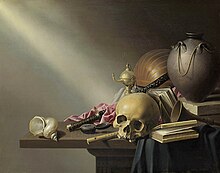
3. David Bailly
Notable works:- Portraits of his students & Flowers and candles.
Qualification:- Flemish immigrant (Cornelius van der Voort).

4. Audrey Flack
Notable works:- Banana Split Sundae, 1981 & Statue of Catherine of Braganza.
Qualification:- The High School of Music & Art (American artist).

5. Georgia O’keeffe
Notable works:- Blue and Green Music, 1921 & Pineapple Bud, 1939.
Qualification:- School of the Art Institute of Chicago (American artist).

Vanitas- Top 4 Famous Paintings
1. Still Life with Skull
Artist: Paul Cézanne
Period: Post-Impressionism
Created: 1896–1898
Genres: Still life, Vanitas
Dimensions: 54 cm x 65 cm
Still Life with Skull is one of the finest paintings by Paul Cezanne. It is one of the paintings he made with a skull as the subject.
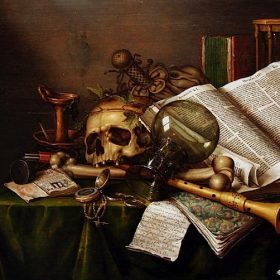
2. Vanitas Still Life
Artist: Jacob de Gheyn II
Created: 1603
Vanitas Still Life paintings symbolize the ephemeral nature of life, reminding viewers of mortality and the fleeting nature of earthly pleasures.
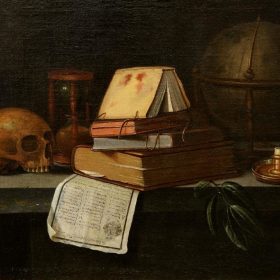
3. Large Vanitas
Artist: Pieter Boel
Created: 1663
Large Vanitas paintings serve as reminders of the brevity of life, showcasing symbolic objects that represent the inevitability of death.
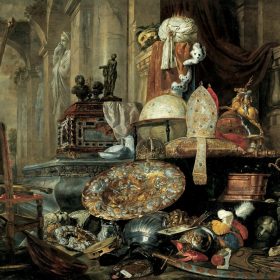
4. Pyramid of Skulls
Artist: Paul Cézanne
Created: 1901
Location: Private collection
Period: Post: Impressionism
Medium: Oil on canvas
Genre: Vanitas
Dimensions: 37 cm × 45.5 cm (15 in × 17.9 in)
The Pyramid of Skulls painting is a haunting depiction of a pyramid composed entirely of skulls, symbolizing the universality of death and the transient nature of life.
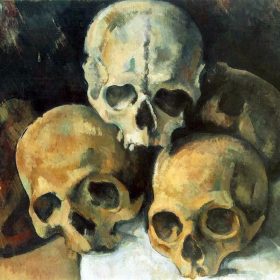
Vanitas- Characteristics
If you want to know the characteristics of Vanitas along with Post-impressionism, Minimalism, and Fauvism.
So here are two categories 1. (Artworks) and 2. (Forms) that explain the various aspects of this art movement.
First category “Artworks” explains the deepness of this art movement and,
Second category “Forms” describes the artistic aspect of this art movement.
There are very famous artworks such as – “Still Life with Skull,” “Vanitas Still Life,” “Still life with skull.” If you observe the artworks of Vanitas, then you can easily guess the characteristics of it.
And also other paintings such as “Pyramid of Skulls” and “Large Vanitas” describe the characteristic of it.
MORE 6 LINES
Vanitas- People also search for
| Top artists | Top artworks |
|---|
Vanitas- Other art movements
Land art
Modernism
Expressionism
Vanitas- Relation with other art movements.
Vanitas has been the part of art history, which artists such as Evert Collier, Harmen Steenwijck, and David Bailly have contributed to a great extent to make it art movement.
Vanitas has given many other renowned artists such as Audrey Flack, Georgia O’keeffe, etc. Vanitas is an art movement of art lovers because Vanitas is a pastiche of many different art styles such as Fauvism, Minimalism, Post-impressionism, etc.
In this article, you would get information about other art movements also such as;
Fauvism
Minimalism
Post-impressionism
If you (As a/an Vanitas student) see the artworks of these art movements, specifically Fauvism and Minimalism, then definitely you would get small similarity.
Indeed, Vanitas is a pastiche of many art movements due to its artists.
Vanitas has a complicated history (Relation of artists of Vanitas), and its specific and precise definition (Of Vanitas) has been the subject of debate.
That’s why, in the realm of art, craft, and aesthetics, the definition of Vanitas is different. But don’t worry; this website (artandcrafter.com– Evert Collier + Vanitas) has covered all aspects.


